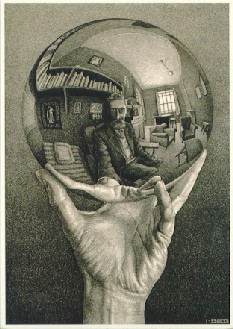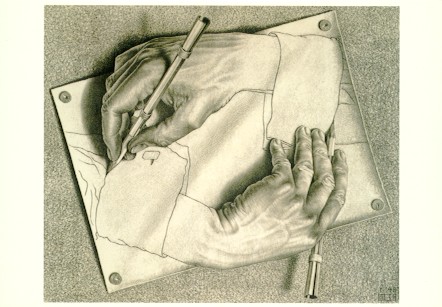


![]()
"The whole world is here for you to enjoy,
but when enjoying, don't forget your Self."
Sri Sri Ravi Shankar
How many times have you asked yourself, "Who am I?"
How many times have you given yourself permission to be exactly who you are... not the roles that you have assumed or have been delegated to you, but the person you were born to be?
You may not know that person very well, yet. You may be surprised at
the depths, the beauty, of that person, when you finally allow yourself
to examine and clarify the essence of who you truly are. And in discovering
the secrets you hold within you, in opening, growing, releasing and embracing
self, you will find that
nothing is impossible...
nothing is improbable...
nothing is too big, or too small, to live inside you...
because you hold the magic of the universe in
every thought and cell.
You are manifestly unique, like the whorls on your fingertips!
Expressing yourself may be one avenue of discovering those secrets, that magic. One way of doing that is by developing the practice of personal journaling. First, you should know that a journal does not have to be a diary of events. That does not mean it can't be, but it can also be a lot more than a simple listing of things that happened.
It can reflect the exact moment that you noticed a spider weaving her web in the window, the color of your child's eyes, the sensation of mud between your toes. It can express the joys, the fears, the immediacy of your life, and capture them like a fern in amber, for you to keep as a reminder, to use as a method of processing, to celebrate the changes that will inevitably occur over time within and around you.
Beginning
"A journey of a thousand miles begins with a single step."
In life, there are two things that are most difficult; beginnings, and endings. Both represent change, whether good or bad, and we are as a rule resistant to change. So, it is vital that we see beginnings and endings not as intractable and fixed, but as part of the continuum, part of the cycles that make up the circle of our existence.
If you talk to many writers, or artists, they will tell you of many times they savored an idea, tasted it, dreamed it, but feared expressing it in case it was not in its form as brilliant as the dream of it. This perfectionism does not serve us in the long run. How many wonderful visions have lived only in the minds of their hosts, beautiful caged birds that have never sung because they have been kept from the light of day? Nothing is insignificant. Observation, enjoyment, and being are as strategic as participating and doing. Sometimes, even more so.
Begin with a cache of items you might find useful in creating your personal journal:
A Blank Book
(this can be a regular journal, though I suggest
lineless pages, a drawing pad... or a scrapbook)
Pencils, Pens, Markers, Crayons, Paint
(whatever you want to mark with... have a variety available)
Paper Glue
(you might find a leaf, a feather, or a comic strip you'd like to add
to your journal,
or feel like creating a collage. I like a glue stick, but use whatever
grabs you)
Something to keep your loose items in
(a designated basket, or a special box)
If you like, you can also include
rubber stamps, stickers, glitter,
different kinds of paintbrushes, and colored paper.
You may find that you use nothing but the blank journal and one special pen that you like to write with. You may want to try everything. Either way, it is your journal. Having the materials available simply gives you some variety of choice, in case you are inspired to put something in your journal spontaneously. I encourage a book without lines because it frees you from the constraints of feeling your journal should be words alone, or words in a line. If you feel like turning the book upside down one day, or writing corner to corner, in a spiral, or whatever, you have the space to do it.
You may end up having many books, of different styles, that you use interchangeably according to your mood, or what you want to keep in them... that is also up to you. You do not have to be Hemingway, or Michelangelo. Nobody ever needs to see your journal but you, unless you choose to share it. You can explore finger painting, dot to dot drawing, stick people, doodles, and scribbles. I pasted a handful of confetti in one of my books, from a wedding I attended. Sometimes, I find something interesting on the ground. There is a gum wrapper there, witness to my efforts to quit smoking cigarettes.
Think of your new book as a time capsule that you will be adding things to as you go along, instead of all at once.
So, we are going to imagine, here, that you have a blank book. It is
smooth, and empty, full of potential. It is like an empty bowl, waiting
for you to fill it, decorate it, again and again. Some people like to begin
by enhancing the covers for a few days, or simply carrying it around and
flipping through it, imbuing it with their own energy. I always like to
write my name inside the front cover, and the date that I began to use
that particular book. If it is a gift, I will write that, too.
The Discipline
"Discipline is not torturing oneself for nothing---that's
no discipline.
The purpose of discipline is to obtain joy."
Sri Sri Ravi Shankar
Here are a few exercises to get you jump started. You may put something in every day, or only when the mood strikes you. But it is a good practice to take a small segment of time for yourself, alone, and play with your book, to develop a relationship with it as your translator, confessor, sounding board and secret friend.
One: Take a blank page, and using as many different words as you can, write down how you feel right now.
Two: Now take a blank page, and without
concentrating on pattern, form, or structure, use your supplies to express
that feeling in picture form.
Are you angry? Hey, it might be a doodle face with the tongue sticking
out.
Are you relaxed? It might be a little sailboat floating around in a
sea of ink.
Three: When you have tried the other exercises, and try them at different times, so that you can experience how it is to express different feelings, try this one.
Take a blank page, and write a hundred things you would do if you could do anything you wanted to do. Be outrageous. Be truthful. By the time you get past fifty or so, you will begin to struggle. Keep going. The more you write, the deeper you are seeking.
When you are finished with your hundred things, read them all and choose a "Top Ten" that you would really and truly love to do. Now you have a Dream List !
Four: Take each item on your Dream List, and express how it would change you, and your life, if you did that particular thing.
See yourself on the beach in Waikiki.
Imagine yourself with that diploma in your hand.
Take a turn in front of the mirror in your new clothes.
Hear yourself belting out the blues in a smoky club.
Visualize yourself meditating in an ashram.
Feel the satisfaction of saying No when you need to.
Feel the pleasure of saying Yes when you want to.
You can express how your dreams might feel with words, or with freeform colors, or with pictures. Experiment with art clipped from magazines evocative of your dream, or draw your own scene. It does not have to be "artistic" or perfect... what is important is how it evokes the feeling in you when you look at it, how it reminds you of your dream.
Five: Imagine that you are a benevolent mentor, and write a letter to yourself. What do you want to say to yourself? How would you express it? Imagine that your "student" (you) is a young child. Does this affect your expectations or how you would express them? How would you help your student formulate goals? How would you evaluate your student's progress so far?
Six: Write a letter to someone that you have always wanted to say something to, but have not done so, either from lack of opportunity or from reluctance or fear. Let it all go. Remember that this is a "letter" that will never be "mailed", so you can explore your anger, frustration, longing, pain or admiration. You can ask for forgiveness or express forgiveness to this other being. If you can't get the words out, bring out your colors, or draw how you feel.

Great Journaling Links!
"Improve
Your Health Through Journaling"
" Hand With Reflecting Sphere" and "Drawing Hands" by M.C. Escher.

Comments? Questions?, Email Caroline
I Am A Proud Member Of:

Phenomenal
Women Of The Web